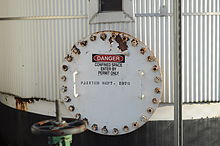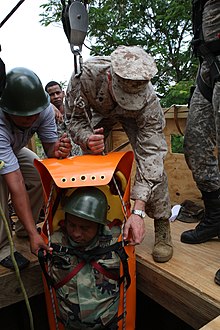50:
115:
127:
This is a last resort option as having more personnel enter an area that has already incapacitated one or more persons places the rescuer at considerable risk. Entry rescues must be carefully planned and executed to avoid creating more victims in need of rescue. Rescuers need to be aware of their
102:
A person may recognize a critical condition or symptoms of exposure, and exit the space without assistance. Alternatively, an entry monitor outside the space may recognize a new hazard and have people leave the space before they are affected. This is the preferred rescue method, as confined space
57:
Confined spaces are often narrow and constricting, preventing easy access by rescuers, making confined space rescues technically challenging;. The spaces are usually unlit or poorly lit, requiring a light source to be provided. Confined spaces may contain
157:
tightly around the wrist or ankle of an incapacitated person. Once the strap is looped around a hand or foot, its attached rope is pulled by rescuers, tightening around the arm or leg and pulling the victim out of the confined space.
89:. The urgent need to rescue someone from a confined space often leads to ill-prepared rescue attempts. Two-thirds of all deaths occurring in confined spaces are attributed to persons attempting to rescue someone else.
153:
A wristlet is often the first item used to actually perform the rescue, as opposed to the ventilator which is used to prepare the environment for a rescue. A wristlet is a cloth strap that is used to
372:
Confined Space Rescue
Services and Training | Every year, hundreds of workers suffer needless injuries, even death, due to inadequate (or non-existent) confined space entry programs.
200:
In the UK confined space is governed by HSE (Health and Safety
Executive), which states that those entering a confined space cannot rely on 999 for rescue.
347:
139:
Due to the unique nature of confined space rescues, there is specialized equipment necessary to perform a safe and successful rescue.
188:
The rescuers may also carry monitoring equipment by which they can ascertain the quality of the air in the environment. Even if the
131:
In the event of an entry rescue, standby rescuers are recommended in the event that the initial entry rescuer(s) encounter trouble.
103:
hazards can quickly incapacitate or kill. A person can almost always exit a confined space much faster than waiting to be rescued.
111:
A non-entry rescue involves attempting to extricate an incapacitated person without having anyone else enter the confined space.
185:
and tripod may be set up over the access point, if the bottom of the confined space is more than five feet from the entrance.
302:
73:
These hazards can be fatal as they create a limited window of time in which to perform a rescue. After four minutes without
181:
with an attached safety line, especially if a vertical descent is required. To assist in vertical descents, a mechanical
128:
surroundings and must reevaluate their plans immediately if there is any change in the conditions of the confined space.
318:
166:
203:
In Canada, The Oil Sands Safety
Association has a certification program for Confined Space Entry and Monitor.
162:
143:
351:
192:
reading does not indicate any hazardous conditions, it is still recommended that rescuers wear SCBA.
227:
264:
8:
59:
298:
23:
319:"AAE Safety CSSTA Confined Space Entry, Monitor and Rescue Safety Training Course"
386:
350:. NASA Ames Research Center - Disaster Assistance and Rescue Team. Archived from
170:
161:
In the event that an entry rescue must be performed, rescue personnel will wear
178:
43:
27:
289:
380:
222:
31:
49:
82:
39:
35:
30:
or in a place only accessible through confined spaces, such as underground
118:
Military and police personnel practicing confined space rescue techniques.
114:
53:
A warning label on a storage tank, indicating that it is a confined space.
217:
212:
189:
142:
One of the initial pieces of equipment employed in a confined space is a
26:
operations that involves the rescue and recovery of victims trapped in a
366:
174:
78:
348:"Emergency Response and Recovery Training and Testing Facility"
74:
63:
371:
291:
Safe Work in
Confined Spaces: Confined Spaces Regulations 1997
182:
86:
146:
to disperse collected hazardous gases and introduce fresh
147:
67:
154:
92:
177:any gases). The rescuer may also wear a full body
165:appropriate for the situation. This may include a
297:(3 ed.). Health and Safety Executive. 2014.
378:
367:Confined Space Rescue and Training Facilities
169:(SCBA), protective headgear and the use of
259:
257:
255:
253:
251:
249:
247:
245:
243:
113:
48:
265:"Is It Safe To Enter A Confined Space?"
379:
240:
134:
106:
13:
282:
167:self contained breathing apparatus
14:
398:
340:
70:form, and oxygen may be limited.
93:Confined space rescue categories
16:Skilled technical rescue methods
122:
311:
97:
1:
233:
195:
77:a person will usually suffer
7:
206:
10:
403:
228:Incident Response Team
150:into the environment.
119:
54:
354:on September 30, 2006
173:lighting (to prevent
144:method of ventilation
117:
52:
20:Confined space rescue
163:protective clothing
60:hazardous materials
120:
55:
304:978-0-7176-6622-5
394:
363:
361:
359:
334:
333:
331:
329:
315:
309:
308:
296:
286:
280:
279:
277:
275:
270:. Cal-OSHA. 1998
269:
261:
135:Rescue equipment
107:Non-entry rescue
24:technical rescue
402:
401:
397:
396:
395:
393:
392:
391:
377:
376:
357:
355:
346:
343:
338:
337:
327:
325:
317:
316:
312:
305:
294:
288:
287:
283:
273:
271:
267:
263:
262:
241:
236:
209:
198:
171:explosion proof
137:
125:
109:
100:
95:
22:is a subset of
17:
12:
11:
5:
400:
390:
389:
375:
374:
369:
364:
342:
341:External links
339:
336:
335:
310:
303:
281:
238:
237:
235:
232:
231:
230:
225:
220:
215:
208:
205:
197:
194:
136:
133:
124:
121:
108:
105:
99:
96:
94:
91:
28:confined space
15:
9:
6:
4:
3:
2:
399:
388:
385:
384:
382:
373:
370:
368:
365:
353:
349:
345:
344:
324:
323:MI Safety Inc
320:
314:
306:
300:
293:
292:
285:
266:
260:
258:
256:
254:
252:
250:
248:
246:
244:
239:
229:
226:
224:
223:Trench rescue
221:
219:
216:
214:
211:
210:
204:
201:
193:
191:
186:
184:
180:
176:
172:
168:
164:
159:
156:
151:
149:
145:
140:
132:
129:
116:
112:
104:
90:
88:
84:
80:
76:
71:
69:
65:
61:
51:
47:
45:
41:
40:storage tanks
37:
36:storage silos
33:
29:
25:
21:
358:September 1,
356:. Retrieved
352:the original
326:. Retrieved
322:
313:
290:
284:
274:September 1,
272:. Retrieved
202:
199:
187:
160:
152:
141:
138:
130:
126:
123:Entry rescue
110:
101:
83:brain damage
72:
56:
19:
18:
218:Mine rescue
213:Cave rescue
190:air quality
98:Self rescue
234:References
196:Regulation
381:Category
328:12 April
207:See also
175:igniting
81:causing
79:asphyxia
179:harness
387:Rescue
301:
75:oxygen
64:liquid
44:sewers
32:vaults
295:(PDF)
268:(PDF)
183:winch
155:cinch
87:death
42:, or
360:2006
330:2023
299:ISBN
276:2006
148:air
85:or
68:gas
66:or
62:in
383::
321:.
242:^
46:.
38:,
34:,
362:.
332:.
307:.
278:.
Text is available under the Creative Commons Attribution-ShareAlike License. Additional terms may apply.

